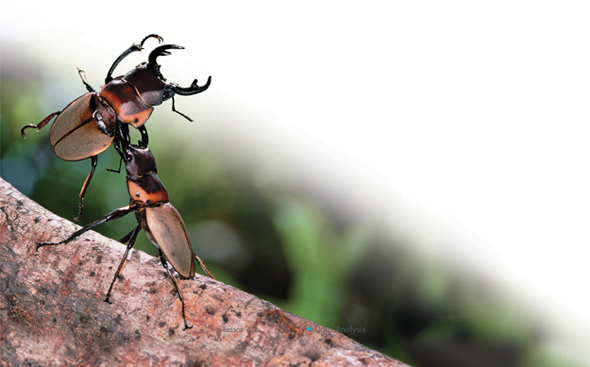Defining the Niche Describing a species' “address” tells only part of its story. Ecologists also study a species' ecological “occupation”—where and how it “makes a living.” This idea of occupation is encompassed in the idea of an organism's niche (nich). A niche describes not only what an organism does, but also how it interacts with biotic and abiotic factors in the environment.  A niche is the range of physical and biological conditions in which a species lives and the way the species obtains what it needs to survive and reproduce. Understanding niches is important to understanding how organisms interact to form a community.
A niche is the range of physical and biological conditions in which a species lives and the way the species obtains what it needs to survive and reproduce. Understanding niches is important to understanding how organisms interact to form a community.
▸ Resources and the Niche The term resource can refer to any necessity of life, such as water, nutrients, light, food, or space. For plants, resources can include sunlight, water, and soil nutrients—all of which are essential to survival. For animals, resources can include nesting space, shelter, types of food, and places to feed.
▸ Physical Aspects of the Niche Part of an organism's niche involves the abiotic factors it requires for survival. Most amphibians, for example, lose and absorb water through their skin, so they must live in moist places. If an area is too hot and dry, or too cold for too long, most amphibians cannot survive.
▸ Biological Aspects of the Niche Biological aspects of an organism's niche involve the biotic factors it requires for survival. When and how it reproduces, the food it eats, and the way in which it obtains that food are all examples of biological aspects of an organism's niche. Birds on Christmas Island, a small island in the Indian Ocean, for example, all live in the same habitat but they prey on fish of different sizes and feed in different places. Thus, each species occupies a distinct niche.
BUILD Vocabulary
ACADEMIC WORDS The noun aspect means “part.” There are two aspects—or parts—of an organism's niche: physical aspects and biological aspects.

FIGURE 4–5 Competition Animals such as these two male stag beetles compete for limited resources. Infer What resource do you think these two males are fighting over?
Competition
 How does competition shape communities?
How does competition shape communities?
If you look at any community, you will probably find more than one kind of organism attempting to use various essential resources. When organisms attempt to use the same limited ecological resource in the same place at the same time, competition occurs. In a forest, for example, plant roots compete for water and nutrients in the soil. Animals, such as the beetles in Figure 4 – 5, compete for resources such as food, mates, and places to live and raise their young. Competition can occur both among members of the same species (known as intraspecific competition) and between members of different species (known as interspecific competition).
 In Your Notebook Look at the beetles in Figure 4–5. Is this an example of intraspecific or interspecific competition? How do you know?
In Your Notebook Look at the beetles in Figure 4–5. Is this an example of intraspecific or interspecific competition? How do you know?
Table of Contents
- Formulas and Equations
- Applying Formulas and Equations
- Mean, Median, and Mode
- Estimation
- Using Measurements in Calculations
- Effects of Measurement Errors
- Accuracy
- Precision
- Comparing Accuracy and Precision
- Significant Figures
- Calculating With Significant Figures
- Scientific Notation
- Calculating With Scientific Notation
- Dimensional Analysis
- Applying Dimensional Analysis




